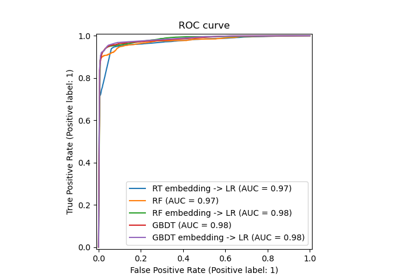-
class sklearn.preprocessing.OneHotEncoder(n_values='auto', categorical_features='all', dtype=, sparse=True, handle_unknown='error')[source] -
Encode categorical integer features using a one-hot aka one-of-K scheme.
The input to this transformer should be a matrix of integers, denoting the values taken on by categorical (discrete) features. The output will be a sparse matrix where each column corresponds to one possible value of one feature. It is assumed that input features take on values in the range [0, n_values).
This encoding is needed for feeding categorical data to many scikit-learn estimators, notably linear models and SVMs with the standard kernels.
Note: a one-hot encoding of y labels should use a LabelBinarizer instead.
Read more in the User Guide.
Parameters: n_values : ?auto?, int or array of ints
Number of values per feature.
- ?auto? : determine value range from training data.
-
- int
-
Each feature value should be in
range(n_values)
- array
: n_values[i] is the number of categorical values in
X[:, i]. Each feature value should be in range(n_values[i])
categorical_features : ?all? or array of indices or mask
Specify what features are treated as categorical.
- ?all? (default): All features are treated as categorical.
- array of indices: Array of categorical feature indices.
- mask: Array of length n_features and with dtype=bool.
Non-categorical features are always stacked to the right of the matrix.
dtype : number type, default=np.float
Desired dtype of output.
sparse : boolean, default=True
Will return sparse matrix if set True else will return an array.
handle_unknown : str, ?error? or ?ignore?
Whether to raise an error or ignore if a unknown categorical feature is present during transform.
Attributes:
active_features_ : array
Indices for active features, meaning values that actually occur in the training set. Only available when n_values is 'auto'.
feature_indices_ : array of shape (n_features,)
Indices to feature ranges. Feature i in the original data is mapped to features from feature_indices_[i] to feature_indices_[i+1] (and then potentially masked by active_features_ afterwards)
n_values_ : array of shape (n_features,)
Maximum number of values per feature.
See also
-
sklearn.feature_extraction.DictVectorizer - performs a one-hot encoding of dictionary items (also handles string-valued features).
-
sklearn.feature_extraction.FeatureHasher - performs an approximate one-hot encoding of dictionary items or strings.
-
sklearn.preprocessing.LabelBinarizer - binarizes labels in a one-vs-all fashion.
-
sklearn.preprocessing.MultiLabelBinarizer - transforms between iterable of iterables and a multilabel format, e.g. a (samples x classes) binary matrix indicating the presence of a class label.
-
sklearn.preprocessing.LabelEncoder - encodes labels with values between 0 and n_classes-1.
Examples
Given a dataset with three features and two samples, we let the encoder find the maximum value per feature and transform the data to a binary one-hot encoding.
>>> from sklearn.preprocessing import OneHotEncoder
>>> enc = OneHotEncoder()
>>> enc.fit([[0, 0, 3], [1, 1, 0], [0, 2, 1], [1, 0, 2]])
OneHotEncoder(categorical_features='all', dtype=<... 'numpy.float64'>,
handle_unknown='error', n_values='auto', sparse=True)
>>> enc.n_values_
array([2, 3, 4])
>>> enc.feature_indices_
array([0, 2, 5, 9])
>>> enc.transform([[0, 1, 1]]).toarray()
array([[ 1., 0., 0., 1., 0., 0., 1., 0., 0.]])
Methods
fit(X[, y]) | Fit OneHotEncoder to X. |
fit_transform(X[, y]) | Fit OneHotEncoder to X, then transform X. |
get_params([deep]) | Get parameters for this estimator. |
set_params(\*\*params) | Set the parameters of this estimator. |
transform(X) | Transform X using one-hot encoding. |
-
__init__(n_values='auto', categorical_features='all', dtype=, sparse=True, handle_unknown='error')[source]
-
fit(X, y=None)[source] -
Fit OneHotEncoder to X.
Parameters: X : array-like, shape [n_samples, n_feature]
Input array of type int.
Returns: self :
-
fit_transform(X, y=None)[source] -
Fit OneHotEncoder to X, then transform X.
Equivalent to self.fit(X).transform(X), but more convenient and more efficient. See fit for the parameters, transform for the return value.
-
get_params(deep=True)[source] -
Get parameters for this estimator.
Parameters: deep : boolean, optional
If True, will return the parameters for this estimator and contained subobjects that are estimators.
Returns: params : mapping of string to any
Parameter names mapped to their values.
-
set_params(**params)[source] -
Set the parameters of this estimator.
The method works on simple estimators as well as on nested objects (such as pipelines). The latter have parameters of the form
<component>__<parameter>so that it?s possible to update each component of a nested object.Returns: self :
-
transform(X)[source] -
Transform X using one-hot encoding.
Parameters: X : array-like, shape [n_samples, n_features]
Input array of type int.
Returns: X_out : sparse matrix if sparse=True else a 2-d array, dtype=int
Transformed input.

Please login to continue.